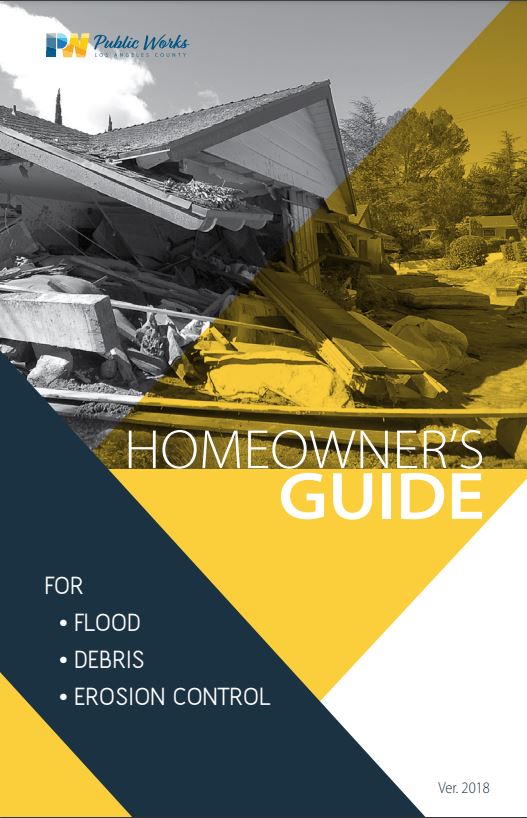Understanding the Risk
Debris and mudflows are highly unpredictable events. Areas that don’t have grass, trees, shrubs and plants, such as after a fire, are more likely to be impacted. The extent and amount of flows will depend on the rainfall intensity and duration of the storm event, and on the extent of recovery of vegetation in the burn areas at the time. These flows can be highly destructive and move large quantities of soil, rocks, brush and trees into neighborhoods, causing property damage, blocking streets and endangering occupants.
It is important for residents who live in areas susceptible to debris and mudflows, such as those on steep hillsides and in canyons, to be prepared for the possibility of such events. Take the following actions to help reduce your risk of death, injury and property losses from debris and mudflows and other types of ground failure.
Mud and Debris Flow Safety Tips (LA County Fire Department)
Be Prepared for Debris and Mudflows
You can reduce the potential impacts of land movement by doing the following:
- Assume that burn areas and canyon, hillside, mountain and other steep areas are more likely to have landslides and mudslides.
- Be prepared well before storm conditions are present. As storms approach, monitor the Los Angeles County Public Works Debris and Mudflow Potential Forecast.
- Clear a path for the debris. Always place protection to deflect debris, not to dam or stop it. Be prepared to sacrifice the use of portions of your property to achieve the greatest amount of protection.
- Work with adjacent affected property owners. Avoid altering drainage patterns that could worsen conditions for your neighbor.
- Debris will often enter a building through windows – board them up.
- Limit the height of plants near buildings to 18 inches.
- Use plants and bushes that are less likely to burn and keep them watered. This not only helps with landslides/mudslides, but is also helpful for fire safety.
- Inspect slopes for increases in cracks, holes and other changes. Get rid of litter and dead/dry vegetation.
- Consult with a soil engineer or an engineering geologist to minimize the potential impacts of landslides.
- Find more information about sandbags on the Los Angeles County Public Works Sandbag dashboard.
Have a Plan and Keep Supplies
In addition to preparing your property, develop a family plan to ensure you are prepared as possible. At a minimum, take the following actions:
- Register with your community’s local emergency mass notification system. Sign up to receive emergency notifications from Alert LA County or identify and sign up for the emergency notification system utilized by your city to stay informed about emergencies and disasters.
- Develop a family emergency plan that includes home evacuation routes, locations of utility shut-offs, and how family members will contact or reconnect with you if separated. Make sure that there is also an out-of-state contact too. Find for more information on making plans for emergencies and disasters.
- Make a disaster supply kit that includes enough food, water and medications that could last for at least 10 days. Keep it handy if case you have to relocate or evacuate immediately, or if your utility services are cut off. Don’t forget the needs of pets, and keep in minds each person’s specific needs when creating your supply kit. View more information on keeping supplies for emergencies and disasters.
- Have supplies to protect your home, including the following: hammer, nails, plywood, rain gauge, sand, sandbags and a shovel. Free sand and/or sandbags are also available at your local fire station.
Staying safe: When it rains

Take Action
- Take steps to protect your home by anticipating runoff and placing sandbags in areas as needed. Board up windows and doors as needed.
- Be ready to evacuate at a moments notice in case your local officials instruct you to do so. You also do not need to wait to be told to evacuate if you feel there is a risk to your safety.
- Check in on vulnerable neighbors.

Monitor
- Be aware of the Los Angeles County Public Works Debris and Mudflow Potential Forecast for your area.
- Monitor the amount of rain during intense storms. More than three to four inches of rain per day, or ½-inch per hour, have been known to trigger mud and debris flows, but exact measurements may vary based on local conditions and circumstances.
- Look for geological changes near your home, such as cracked soil, bulging slopes, new holes on hillsides, or muddy waters.

Stay Informed
- Sign up to receive emergency notifications from Alert LA County or identify and sign up for the emergency notification system utilized by your city
- Follow directions from emergency responders in your area at all times.
- Stay up to date on forecasts and conditions by monitoring local television and radio news broadcasts. Have a battery powered radio available in case of power loss.
Los Angeles County residents, renters, and business owners, including persons with disabilities and others with access and functional needs, may call 211 LA County for emergency preparedness information, and other referral services. The toll-free 2-1-1 number is available 24 hours a day and seven days a week. 211 LA County services can also be accessed by visiting https://211la.org



